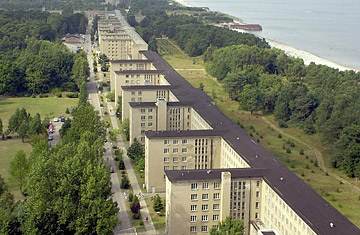
The so-called Colossus of Prora on the island of Rügen was originally a Nazi project. Now the complex is part hostel, part tourist attraction

This post is in partnership with Worldcrunch, a new global-news site that translates stories of note in foreign languages into English. The article below was originally published in Die Welt.
As the bus turns a corner, passengers' eyes follow where the man with the microphone is pointing. Through the bus windows, though still 4 km away, they get just a glimpse of what they've come to see: large blocks of buildings partially hidden by trees. A man working in his garden nearby notes: "That's already the fourth bus this morning. They come past here, then drive along the whole complex at walking speed, turn around and drive back out in that direction."
Up close at the giant complex, cameras at the ready, people try to find some way to get the whole thing into one shot. Impossible. Many opt to take a series of shots, saying that when they get home they'll paste the images together to make one ensemble view.
The fact is that Germany's largest building — six stories high, 4 km long — can only be photographed in its entirety from the air. Whether you approach it from land or sea, it's impossible — because of the way it's built into the land, surrounded by forests and dunes — to take it all in at once.
This is Prora, on the island of Rügen in the Baltic Sea. And if Rügen is Germany's largest island, Prora is the biggest vacation machine ever built on the planet. The Deutsches Jugendherbergswerk, the association of German youth hostels, has opened its largest hostel with over 400 beds there. The facility fills only about a third of Block 5.
The hostel offers some 100 modern rooms of two, four or six beds each. Sixteen rooms are wheelchair-friendly, and there are seven meeting rooms. For three and a half years, the youth-hostel association has also been running a Prora youth camping ground with room for approximately 1,000 guests.
Besides its size, there is nothing else out of the ordinary about the new hostel. But debate has been engendered by the wording of the hostel's first brochure (removed from the present edition), which described the hostel as being on the site of the "world-famous KdF resort." KdF stands for "Kraft durch Freude" (Strength through Joy), which was a state-controlled organization in Nazi Germany that sponsored leisure activities. Many found it inappropriate to trumpet the complex's Nazi heritage as a plus point.
But there's another reason for quibbling about the wording: though world-famous, even just because of its sheer size, the complex was never actually a KdF spa.
Change of Plans
Prora was under construction from 1936 to 1939, and was being promoted by KdF as a seaside resort for 20,000 people. However, the project was never completed. Construction stopped because of the war. Instead of holidaymakers, the bare shells of the buildings were equipped to house people who had fled the bombings in Hamburg. What the complex would have looked like if it had been finished, nobody knows — the plans are missing. Later, the complex was completed to accommodate members of the East German army and police force, so it is more DDR-style than anything else.
Not even the megalomania of the basic concept can be attributed to Nazi ideology. While Cologne architect Clemens Klotz (1886–1969) did design party schools (Ordensburgen) for Hitler, at Prora he was actually referencing the most modern designs celebrated in international architecture publications: the Obus and Fort l'Empereur projects for Algiers developed by the Swiss-born architect Le Corbusier (1887–1965). These involved apparently endless rows of housing 100 m high and up to 25 km long. The buildings were supposed to follow the Mediterranean shoreline like ramparts, house 180,000 people and have highways built on the roofs — signature stuff for a new era in urban planning.
For Prora, Klotz reduced the height of the buildings to six stories, the length to 4 km, the number of people the complex could house to 20,000 and planned for underground traffic. Instead of highways on the roofs, there was supposed to be a subway that connected the building blocks.
The only really "Nazi" aspect of Prora was a central outdoor "Festplatz" measuring 400,000 sq m. There, Hamburg architect Erich zu Putlitz was supposed to build a temple-like hall with seating for 20,000 holidaymakers, but construction never got under way.
What was built, at least in skeletal form, were the blocks to accommodate guests. KdF holidaymakers were entitled to space measuring 2.5 by 5 m with two beds, a sofa, table, chair, closet and sink. The repetition of the same elements having the same functions puts these blocks much more squarely in the camp of the modern rather than anything inherently Nazi.
After the reunification of Germany, the Prora complex, which is unique in the world, was given a heritage listing, placing certain hurdles in the way of would-be entrepreneurs seeking to develop it. Most of the blocks are completely empty. However, with the opening of the youth hostel, and given Rügen's growing popularity as a place for vacation homes and B&Bs, attitudes toward the complex are changing.
Local politicians are supporting its development and Thomas Kohler, president of Germany's national association of youth hostels, sees potential for a center where exhibitions, tours and workshops feature the history of Prora. In this way, the odd construction would have value not only as a beach resort but as a cultural destination as well, of interest to Germans and international visitors alike — something the busloads of visitors already making pilgrimages to the site will undoubtedly welcome.
Also from Worldcrunch:
The Gambler: Dominique Strauss-Kahn, A Psychological Profile.
— Le Monde
The Libyan Diaspora and the War.
— Le Monde
Poland: Tragedies Of The Past, Hopes for the Future.
— Le Temps
